For manufacturers of ergonomic & office chairs new ideas can create threats and also opportunities. Creative disruption works. Familiarity and normalcy biases are the major holdup by preventing the move to a change to the new breed of chair. Incremental ergonomic improvement for upright sitting has come to the end of a road with only limited benefit. Will they grab this opportunity?
Business theorist Clay Christensen says “The reason [for why great companies failed] is that good management itself was the root cause. Managers played the game the way it’s supposed to be played. The very decision-making and resource allocation processes that are key to the success of established companies are the very processes that reject disruptive technologies: listening to customers; tracking competitors actions carefully; and investing resources to design and build higher-performance, higher-quality products that will yield greater profit. …. “These are the reasons why great firms stumbled or failed when confronted with disruptive technology change.”
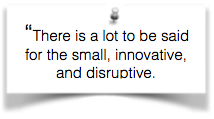 The phrase ‘creative destruction’ was coined by Joseph A. Schumpeter in his book ‘Capitalism, Socialism & Democracy’ (1942) in reference to political systems. He pointed out that large organisations needed not to fear competitors, but only the future, with the arrival of new technology, markets, production methods, and goods. Capitalism was the only system with the dynamism to achieve this through creative destruction. This has has been confirmed many times in recent history: comfortable incumbents, making incremental changes to their designs and then a disruptor emerges, and they’re dead. Kodak is an example. The car industry is an ongoing example. Performance has improved compared to that of a car of only ten years ago. But the experience of driving is essentially the same and the gains are marginal. They are now threatened by the new technology of outsiders who have very little to lose. These can disrupt the market so fundamentally that everyone else has to change their business model or go bust. Traditional car firms are worried about the likes of Google (driverless cars). Tesla (driverless and long range electric). And Apple ( Project Titan?). Ubers disruption of Taxi monopolies. This is also happening in the office chair industry. The ergonomics have been improved incrementally for upright sitting with only limited benefit and has come to the end of a road. A new fix is required if the increasing incidense of spinal conditions associated with prolonged sitting are to be reduced. A paradigm change?
The phrase ‘creative destruction’ was coined by Joseph A. Schumpeter in his book ‘Capitalism, Socialism & Democracy’ (1942) in reference to political systems. He pointed out that large organisations needed not to fear competitors, but only the future, with the arrival of new technology, markets, production methods, and goods. Capitalism was the only system with the dynamism to achieve this through creative destruction. This has has been confirmed many times in recent history: comfortable incumbents, making incremental changes to their designs and then a disruptor emerges, and they’re dead. Kodak is an example. The car industry is an ongoing example. Performance has improved compared to that of a car of only ten years ago. But the experience of driving is essentially the same and the gains are marginal. They are now threatened by the new technology of outsiders who have very little to lose. These can disrupt the market so fundamentally that everyone else has to change their business model or go bust. Traditional car firms are worried about the likes of Google (driverless cars). Tesla (driverless and long range electric). And Apple ( Project Titan?). Ubers disruption of Taxi monopolies. This is also happening in the office chair industry. The ergonomics have been improved incrementally for upright sitting with only limited benefit and has come to the end of a road. A new fix is required if the increasing incidense of spinal conditions associated with prolonged sitting are to be reduced. A paradigm change?
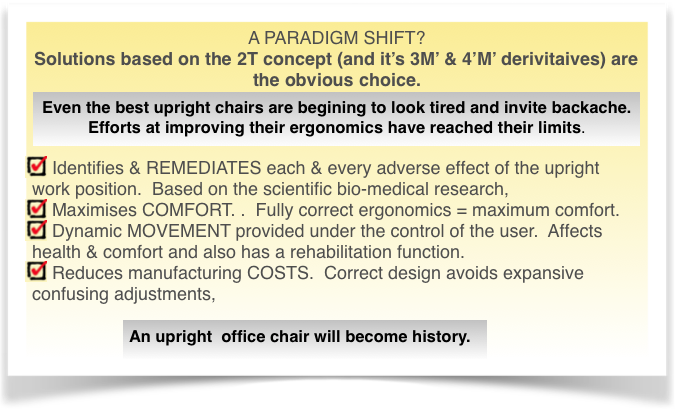
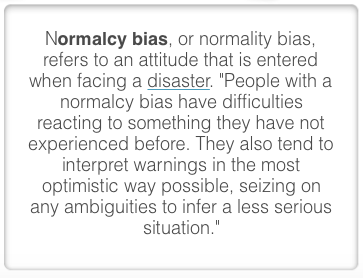 The bias holdup. Failure to understand familiarity and normalcy bias is likely to lead to serious problems for manufacturers of ergonomic & office chairs, however big. We are hardwired to believe the world we live in today and to which we are acclimatised so that we become incapable of comprehending and believing that change is coming . It’s a dangerous trap for manufacturers of ergonomic chairs to fall into and it can blind recognition to a very real and credible threat. (→Familiarity bias). The manufacturers of ergonomic chairs which are claimed to be ‘ergonomic’ seem to have designers who fail to understand the scientific basis of correct ergonomics and chairs are marketed which are nearer ‘machines for making backache’.
The bias holdup. Failure to understand familiarity and normalcy bias is likely to lead to serious problems for manufacturers of ergonomic & office chairs, however big. We are hardwired to believe the world we live in today and to which we are acclimatised so that we become incapable of comprehending and believing that change is coming . It’s a dangerous trap for manufacturers of ergonomic chairs to fall into and it can blind recognition to a very real and credible threat. (→Familiarity bias). The manufacturers of ergonomic chairs which are claimed to be ‘ergonomic’ seem to have designers who fail to understand the scientific basis of correct ergonomics and chairs are marketed which are nearer ‘machines for making backache’.
 Spinal bio-mechanics dictates that prolonged sitting should be performed in a reclined position.This involves a number of requirements.
Spinal bio-mechanics dictates that prolonged sitting should be performed in a reclined position.This involves a number of requirements.
To be effective these are detailed in the 2T CONCEPT a full solution.
The 2Tilt concept. The implications
- A fully 2T compliant chair is fully ergonomically optimised (and optimally comfortable).
- By remediating the adverse bio-mechanical factors, the more the proposed model becomes 2T compliant.
- Prospective manufacturers can be helped to leap ahead of the field.
- ☛ For Implications & likely uptake→.
- 2T chairs may become obligatory for prolonged sedentary use. In this event there will be considerable loss to manufacturers and offices that use mid-upright chairs if they fail to
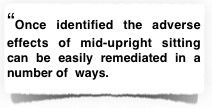
- Only a few firms wish to have a ‘retro’ look. Most manufacturers of ergonomic chairs want to project a cutting edge image. ‘Coolness’ is the word. A 2T chair answers this exactly and in addition reduces LBP and increases productivity by lessened morbidity and stress.
- Once a 2T chair hits the market there will be much media interest providing automatic PR. Firms without a 2T model are likely to be disadvantaged.
- Some manufacturers of ergonomic chairs, are mentioned in ‘ Various chairs. How do they measure up? ‘. Interesting for various reasons and Intended only to illustrate points in relation to the 2T concept. LBP (& 2T) is already of interest to Insurance.
- 2T chairs may become obligatory for prolonged sedentary use. In this event there will be considerable loss to manufacturers and offices that use mid-upright chairs if they fail to
THE OFFICE OF THE FUTURE
With the advent of AI and robotics offices will be geared to the emotional and physiological requirements and wellbeing of the highly paid staff. 2 Tilt chairs and their 4M derivatives will be exactly relevant.
The Global environment. Where does the 2T chair stand in relation to the global environment and recycling?
- The 2T simplicity of design allows it to have the potential to be superior to any other equivalent task chair for impact on environmental factors like global warming, smog, resource depletion, and waste.
- With virtually no, or fewer, complex moving parts, controls and widgets, manufacturing processes and costs are reduced.
- Manufacturing cost usually account for a large proportion of the energy cost of a product.
- Any materials considered safe to the environment can be used.
- Recycling. Components can be either used as biological nutrients or transformed into commercial commodities available for industry.
- Disassembly. With fewer widgets and working parts this is easier than other high-end task chairs.
- Large amounts of oil, gas, and coal is required to mine raw ores, crush them, transport them, smelt them down and turn them into stock, transport them again, and turn them into end-products. . . then transport them again.
The words of Jim Platts. MfI Department. University of Cambridge are relevant to manufacturers …
There is a small detail that you might like to add in to your forward thinking, which takes the notion of some form of certification for ‘good’ chair shapes a step further than we discussed yesterday.
What is to me so delightful is Dr Henry has very elegantly identified the core detail of ‘good sitting’ as maintaining the angle of the pelvis, so that the first few vertebrae above it are sustained in their right geometric relationships and carry their loads easily, without the geometry becoming distorted and the surrounding tissue strained, causing back problems. The notion of some form of certification process hinges around the understanding of the notion of ‘good sitting’.
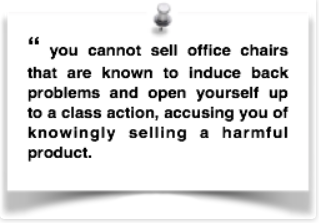 There is a step beyond this. Once the notion of ‘good sitting’ becomes not only well understood but also well accepted – and I think we have enough clarity from all the work that Dr Henry has pulled together, and enough medical agreement about that work, for this to happen – there comes
There is a step beyond this. Once the notion of ‘good sitting’ becomes not only well understood but also well accepted – and I think we have enough clarity from all the work that Dr Henry has pulled together, and enough medical agreement about that work, for this to happen – there comes
I guess the example would be seat belts in cars. It is not only that they save lives for those in the car. They save an inordinate amount of accident and emergency time and effort in hospitals on Saturday nights. So we don’t wear seat belts ‘because they are a good thing’ we wear them because not to do so is a bad thing.
There are of course many, many ways of producing ‘good sitting’. But where I think there is real value in the simple clarity that Dr Henry has achieved in his work, is that the essentials of ‘good sitting’ are made very clear. And THAT – the spreading of that message – in the end has the power to ban ‘bad sitting’.
Best regards, Jim
